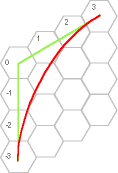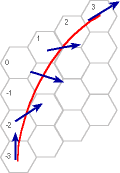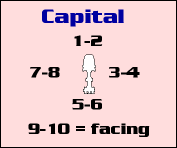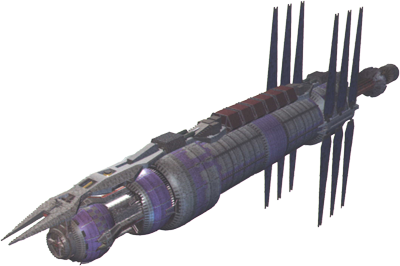
 |
||||||||


These rules require a substantial modification of the ship control sheets. (SCS)

The game is played in rounds on a hex grid in 5 phases
Each ship rolls a d20 and adds the result to that ships bonus. Ships move in initiative order. Thus large slow ships move first and fast agile ships move last to best position themselves out of arc of the slower ships weapons.
Ships may divert power from one weapon to another to reduce its recharge time. Each turn a weapon may accept additional power equal to one turns charge thus reducing its recharge time by 1 round. If the additional power comes from other weapons that weapon must be shut off completely and loses whatever power it had stored; excess power is wasted.
After 2 turns continuous firing a weapon must cool down for one turn.
Any ships launching ballistics declare a launch and state the missile or torpedo's target.
If a ship does not apply thrust it will continue to travel at the same speed in the same direction.
Ships move in initiative order, lowest to highest. Ties are decided by a straight roll off, no bonuses.
Ships have a given amount of thrust which may be applied to change speed or direction. A ship's movement table gives the thrust required for accelerating and turning.
|
The large (red) number is the thrust available, the number after "accn" is how much thrust it required to change speed by 1 hex. With 12 thrust and an acceleration cost of 3 this ship could accelerate by 4 hexes each turn.
Only ships with retro thrusters may decellerate, other ships have to pivot 180 degrees before applying thrust to slow themselves down.
Turns do not happen instantly, the captain barks out an order, the helmsman follows it and the ship pivots, applies thrust and slowly starts heading off in the new direction.
Applying the ship's maximum thrust throughout the round the movement table indicates how many hexes must be travelled at a given speed before the ship is effectively heading in the new direction. It allows modifications to be made for changes in the available thrust.
The movement table's first row is the ships speed and the second row is the number of hexes it must travel before it has changed heading.
|
A Var'Nic going at speed 6 and applying all its thrust in an effort to turn must travel 3 hexes forward after the player has declared the turn. If it has sufficient movement left during the round it may turn again as it may apply the thrust to turn throughout the round.
This assumes that the ship has its full power available, which won't be the case if it is accelerating, decelerating or has had thrusters shot off. In these cases the turn delay must be increased. For each point of thrust not available you work your way in a zig zag up the table increasing the turn delay, starting from your highest speed.
If the Var'Nic was to accelerate from 6 to 7 it uses 3 thrust, if it wants to turn as well the turn delay is calculated form the highest speed of 7 and then adding 3 zigs as 3 thrust was used for accelerating. Thus the delay would go from 4 down and right to 5, up and right to 5 again and finally down and right to 6. So the player would not be able to turn the ship until the 6th hex.
|
If the Var'Nic was to decelerate from 6 to 5 it again uses 3 thrust, if it wants to turn as well the turn delay would start at the highest speed of 6 and go from 3 down and right to 4 up and right to 4 again and finally down and right to 5. So the player would not be able to turn the ship until the 5th hex.
|
During the turn the ship in reality pivots past the turning angle applying thrust to reduce it's forward speed, whilst at the same time applying thrust in the new direction.
 |
 |
| Actual ship course | Ship's pivot during turn |
|---|
* In reality it should be a proportion of the turn delay but that would slow the game down for no appreciable benefit.
All ships may pivot by
Ships may pivot even if they have lost their thrusters or engine as they use multiple small manouvring thrsuters.
Gravitic drives or ships with retro-thrusters apply thrust to slow down . Ships without retro-trhusters pivot 180 degrees and then apply thrust to slow themselves down ending up facing the opposite direction to the way they are travelling.
Slides are simply an acceleration to the port or starboard. After the appropriate delay for pivoting to the correct direction (i.e. 60 or 120 degrees) the ship may accelerate causing a slide. Slides continue from round to round unless checked.
After pivoting a ship may or may not decide to pivot back to the original heading. For a 60 degree pivot this would leave only 1/3 of the thrust for the slide acceleration, it is not possible at all for a120 degrees pivot.
A ship may roll whilst performinng other manouvres effectively turning it upside down. These are completed at the end of the movement phase.
Agile ships may perform snap manouvres, that is before movement or after all movement has taken place they may pivot or roll. This is done in initiative order. These manouvres cost no thrust.
Agile ships which have lost a side are no longer agile.
Ships using gravitic drives may apply thrust in any direction. They may change speed whilst pivoted and turn whilst facing any direction.
The firing phase has 2 sub-phases
Missiles, torpedoes and other ballistics strike (Use normal ships firing rules)
There are 5sub-phases to firing
You must roll equal to or under the ships target signature to score a hit
Target signature = ships signature + range modifier
Each weapon has a range modification table. As the range increases the modifier decreases becoming negative at long ranges.
| Weapon - Range |
0 |
1 |
2 |
3 |
4 |
5 |
6 |
|---|---|---|---|---|---|---|---|
| Medium Laser |
10 |
12 |
9 |
6 |
3 |
1 |
-2 |
Certain types of shot such as ballistics, plasma or matter may be intercepted. Each weapon that has an ability to intercept is noted with a intercept capability such as -1. Each weapon intercepting may only make one intercept attempt per round and may not fire offensively.
The number of weapons attempting to intercept is decided before any intercept rolls are made.
Each intercepting weapon is rolled seperately on a d10, if the number is lower than or equals the weapons intercept capability the shot is blocked. Against pulse attacks successful intercept attempts block the number of pulses rolled. Against slow moving ballistics the intercept value of all weapons is increased by one (including weapons
| Roll | d10 | <= |
intercept value |
| Pulse weapons | Value | = |
number of pulses intercepted |
| Ballistic weapons | +1 |
to intercept value |
Ships are in three dimensional space so may easily hit locations on the other side of a ship if they are above or below the target. To make the game quicker all of a ship's weapons hit the same side of the target. Roll a d10 and consult the location chart for the ship, some ships such as Drazi have specialised location charts.
 |
 |
 |
Roll a d20 and consult the location chart for the side hit
Roll damage according to the weapon table.
Deduct the armour value from the damage (half if the item or side has been destroyed) and cross off the structural boxes for the item hit.
Note :Some types of weapons have special attack modes, matter weapons ignore armour as they punch right through it, plasma weapons ignore half armour as they burn it away.
If a system or weapon is destroyed the remaining damage transfers to the structure underneath. No additional armour is counted
If the structure on a side is completely destroyed the remaining damage penetrates to the primary section and a random location is rolled.
If a primary system is destroyed any remaining damage transfers to primary structure
| System | --> | Structure |
| Structure | --> | Random primary location |
| Primary | --> | Primary structure |
The fighters phase has 3 sub-phases
All fighters targeting another fighter fire simultaneously.
Any fighters which suffered damage must survive a drop out roll to continue. The fighter must roll <= their remaining structure on a d6.
Any fighters which have survived the onslaught of defending fighters and ship defenses have now penetrated close enough to target the ship and may attack.
Each weapon damaged during the round must roll a critical to see if it is still working. If it rolls equal to or less than the number of boxes it has left on a d10 it has survived.
Other systems suffer criticals for each row or block destroyed
| System | Per row destroyed |
|---|---|
| Thrusters | -1 thrust |
| Sensors | Reduce sensor rating by 1 |
| C&C | -2 initiative |
| Shield generator | -1 shield |
| System | Per block destroyed |
|---|---|
| Reactor | - 1 power |
| Engine | -1 thrust |
| Jump engine |
1% blow up shuip if used |
• Use ½ armour on facing side (round down)
• All shots to primary
Per lost side
• Turn delay is increased by 2 zigs.
• Signature increased by 2 points.
• Initiative -6
• 50% of initial jamming / stealth capability.
